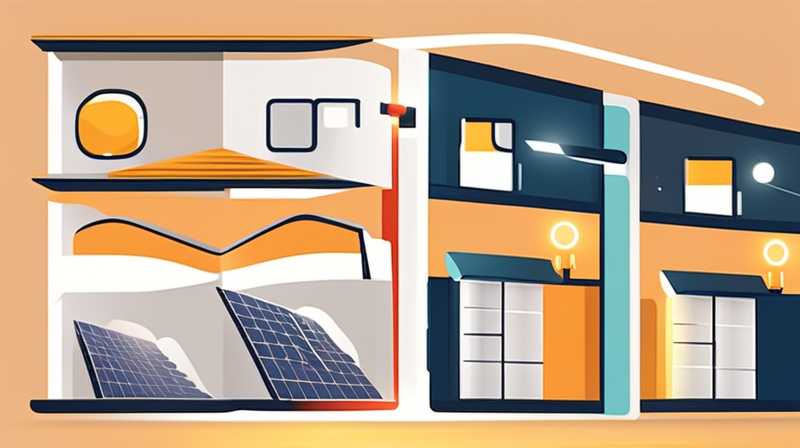
1. TO MATCH LIGHTS WITH SOLAR PANELS AT HOME, FOLLOW THESE STEPS: 1) ASSESS YOUR ENERGY NEEDS, 2) SELECT COMPATIBLE LIGHT FIXTURES, 3) INVESTIGATE SYSTEM INTEGRATION, 4) CUSTOMIZE AND INSTALL. A comprehensive understanding of these steps ensures compatibility, efficiency, and effectiveness of solar power utilization. Specifically, evaluating energy requirements is vital because it dictates the types and number of lights you can effectively run on solar energy, ultimately leading to cost savings and energy independence.
1. ASSESS YOUR ENERGY NEEDS
Understanding energy demands forms the foundational step in integrating lighting with solar technology. To begin, meticulously calculate the total wattage required for the fixtures you envision using. This involves determining the wattage rating of each light bulb, considering their intended usage and the duration they will operate each day. Incorporating this information provides a clear picture of your overall energy consumption.
Next, it is essential to evaluate the hours of natural sunlight your location receives. This factor significantly influences the efficiency of solar panels. Generally, areas with consistent sunlight will yield more power, allowing for more extensive lighting installations. Once you have compiled this information, you can use it to establish the scale of the solar panel setup needed to meet your lighting requirements effectively.
2. SELECT COMPATIBLE LIGHT FIXTURES
Upon determining your energy needs, the next critical task is to choose light fixtures that align effortlessly with solar technology. Light Emitting Diodes (LEDs) are optimum choices due to their exceptional luminescence per watt. LEDs offer durability coupled with energy savings, as they use significantly less power than traditional incandescent or fluorescent bulbs.
In addition to LED selection, consider installing fixtures specifically designed for outdoor use. These often come with weather-resistant features that enhance their longevity. Moreover, features like motion sensors or photovoltaic cells integrated into outdoor lights can optimize energy usage, ensuring lights activate only under specific conditions. Carefully analyzing compatibility will guarantee that the fixtures you select work harmoniously with the solar panel system you plan to install.
3. INVESTIGATE SYSTEM INTEGRATION
The integration of lights with solar panels extends beyond mere fixture selection; it necessitates comprehensive planning of the entire electrical system. Understanding how solar energy is converted and stored is fundamental. Solar panels convert sunlight into direct current (DC), which is then transformed into alternating current (AC) through an inverter if necessary. This process is vital for making power usable for conventional lighting systems.
Furthermore, incorporating a battery storage solution can significantly enhance the effectiveness of your solar-powered lighting. This allows for energy produced during the day to be stored for use at night or during cloudy conditions. Battery selection should also involve consideration of capacity and discharge rates; appropriately sized batteries will ensure that you have enough stored energy to meet your lighting needs when solar generation is low.
4. CUSTOMIZE AND INSTALL
Once planning and research have been conducted, the implementation phase begins, which involves customizing and installing the solar lighting system. It is advisable to develop a detailed installation plan that incorporates the layout of solar panels and light fixtures. This includes determining geographical placements to maximize sun exposure effectively. Each panel’s positioning can significantly impact the amount of energy collected; hence, optimal placement should be prioritized.
Installation can either be undertaken personally or by hiring a professional. If choosing the latter, ensure that the individual possesses substantial experience in solar installations to guarantee a seamless setup. Careful adherence to local regulations, such as building codes or zoning laws, is paramount throughout the installation process to avoid future complications.
FAQs
HOW DO SOLAR LIGHTS WORK?
Solar lights operate by capturing sunlight during the day through solar panels, which convert sunlight into electricity. This electricity charges a battery connected to the light fixture. As dusk falls, the light sensor activates the lighting system, drawing power from the charged battery, thus illuminating the area. The efficiency and longevity of solar lights hinge on several factors, including the sunlight exposure received during daylight hours and the quality of components such as the solar panel and battery. Choosing high-quality materials can prolong the lifespan of the system, while strategic placement is crucial to maximize energy collection.
CAN SOLAR PANELS POWER INDOOR LIGHTING?
Yes, solar panels can indeed power indoor lighting. To achieve this, a solar energy system can be installed on the roof of a home, collecting sunlight to generate electricity that is then used to power indoor lights. This setup typically requires a power inverter to convert the stored DC electricity into usable AC electricity, which is standard for conventional fixtures. When integrating solar panels for indoor use, it is essential to assess energy consumption levels and ensure the solar array is large enough to meet these needs, especially if multiple lights are operated simultaneously.
WHAT ARE THE BENEFITS OF SOLAR LIGHTING SYSTEMS?
Solar lighting systems offer numerous advantages. One of the most compelling benefits is reduced electricity costs. By harnessing the sun’s energy, homeowners can minimize reliance on conventional power sources, leading to significant savings on utility bills. Furthermore, solar fixtures contribute positively to environmental sustainability by reducing carbon footprints. Many models are also equipped with motion sensors, enhancing security while promoting energy efficiency. As technology advances, solar lighting options have progressively become more aesthetically pleasing, enabling versatile designs that integrate seamlessly into various home styles.
In summary, integrating lights with solar panels at home provides advantages in energy efficiency, cost savings, and environmental preservation. One must assess energy needs thoroughly, select the appropriate fixtures, investigate system integration, and customize the installation. Proper planning and research lay a robust foundation for a successful solar lighting project, ensuring that homeowners enjoy the benefits of renewable energy while contributing positively to sustainable practices. Transitioning to solar energy involves more than just choosing components; it requires a holistic approach that considers future needs, aesthetic aspects, and environmental impact.
Original article by NenPower, If reposted, please credit the source: https://nenpower.com/blog/how-to-match-lights-with-solar-panels-at-home/


